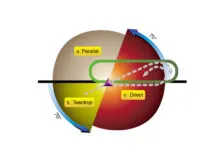Our training for the instrument ticket focused on flying by reference to instruments, how to shoot approaches, holds etc. By that point pilots were presumed to have mastered the art of landing, so who needed any more instruction on that? (Or, so the argument goes.) Your approach speed is an essential precursor to a good landing, even—or perhaps especially—for an instrument pilot. More specifically, fast (aka high-energy) approaches, can be requested by ATC and become a trap, and possibly lead to a bent airplane or, worse still, a fatal outcome. Let’s start by looking at that trap.
High-Energy Approach Trap

Do you fly into busy airports frequented by fast-moving, heavy iron (usually in Class C and B airspace)? Ignoring sky-high avgas prices and fees for everything, there are some advantages to the bigger airports—around-the-clock services, maintenance, passenger pick up from a commercial flight, not to mention on-site emergency services should you need them.
You’re probably familiar with the routine from the TRACON: “Cessna 123, maintain your best forward speed, Boeing 737 in trail.” You push the “go-fast” knob, intercept the ILS and streak downhill. Of course, you’ll eventually have to slow, maybe add flaps (and extend the gear?)—not often easy in a descent. Know your airplane and all this might be relatively straightforward. Still, you’ll likely cross the threshold well above the recommended landing speed and float for quite a while as you slow. It’s a long runway so even with the wheels kissing the pavement with half the pavement behind, the airplane is slowed and you vacate the runway. All’s well that ends well—this time.
We Love Fast Approaches
Of course, there are times at Pea Patch Municipal where you also need to keep your speed up. Gusty winds, quirky eddy currents on approach, and other factors can add airspeed on the approach. But, barring those, a high-speed approach and landing by the general aviation pilot is seldom required by light aircraft. As a nerdy scientist trained to make observations, I’ve found that GA pilots have a propensity for coming in hot in conditions that hardly warrant a jet-like approach speed. Hmm … could they just be trying to manage the Hobbs?
But, what’s too fast for a particular make/model? Is it just subjective? Absolutely not. There are criteria that can define what’s too fast. A plane floating a long way down the pavement, porpoising, wheel-barrowing or bouncing multiple times means excess energy.
This isn’t new behavior. Back in your bell-bottom days of 1976 with Elton John and Kiki Dee crooning “Don’t Go Breaking my Heart,” NASA researchers reported this tendency for GA pilots (students through commercial) with a range of experience (30-1,000 hours) flying four-seat, singles: More than 60 percent of the 1616 landings were fast. The NASA scientists used a “considerable float” to define “fast.”
So What?
Of course, this begs the question, “Does it matter?” Yes. It’s more than finesse or grumpy scientists in their academic silos. In a more recent research study using the NTSB accident database, an Embry-Riddle scientist found that between 1997 and 2016, 38 percent of GA landing accidents were high-energy-related. In that report, a “high-energy” landing accident was any in which the NTSB cited multiple bounces or porpoising or floating.
On the flip side, only four percent of landing accidents were linked to inadequate airspeed. This more recent study resonated with the NASA study on landing technique 40 years earlier. Thus, high-energy approaches continue to be the norm for the GA pilot. As the saying goes “the more things change, the more they stay the same.”
Remember, a prop strike (say after wheel-barrowing or porpoising) requires an expensive

teardown inspection. Your popularity with your insurance company will likely suffer, too. Running off the runway end can also lighten your wallet, particularly if there’s a ditch or obstacle turning your beloved machine into an accordion. But that’s the fairly benign outcome stuff. Dig into the NTSB accident database and one can find more than a handful of pilots who on a (too late) go-around stalled their aircraft or collided with obstacles/terrain resulting in a life insurance payout to their family.
Let’s play with some numbers. Tack on an extra 20 knots to an approach speed for an aircraft that should be flown at 70 knots and the landing distance is doubled. Remember the physics too. The force exerted on an occupant quadruples with a doubling of speed. Not surprisingly, fatal injuries ratchet up two-fold for GA landing accidents involving excess energy.
Back to Basics
As instrument pilots, the importance of the stabilized approach was hammered into our heads during training. Configure the aircraft (flaps, landing gear, and approach power setting) somewhere around the final approach fix and head down the three-degree glideslope to be at VRef on short final. As a refresher, VRef is the speed of the airplane in a specified landing configuration, at the point where it descends to 50 feet AGL. In pilot-parlance this is commonly referred to as “crossing the fence” or “over the numbers.” Don’t think VRef is some number conjured up by the manufacturer. It is strictly defined as 1.3 × VSO—the aircraft stall speed in the landing configuration.
Here’s the catch though and it doesn’t matter whether you’re flying heavy iron or a light sport; the same principle applies. VSO (and subsequently VRef) varies with aircraft weight. Decrease the aircraft landing weight (fewer passengers, no luggage, less fuel) and both values are reduced.
For transport-category aircraft, the flight manual must include adjustments for landing speed based on weight. There can be a notable difference too. VRef for a lightly loaded B-727 (I know this is an old beast but it makes the point nicely) comes to 112 knots compared with 147 knots for a heavy load—a 35 knot difference.
However, manufacturers of light aircraft (under 12,500 pounds) are only required by their regs to specify one landing speed and this value is computed for the aircraft loaded to the gills (i.e. maximum certificated weight). How often do you land at maximum certificated weight? I suspect rarely, if ever. (Unless you take off over gross.)
Okay before someone bombards me with the argument that VRef doesn’t vary much for light aircraft, let’s just see if it does. For a landing Cessna 172S with a single occupant of 182 lbs. and with three-hours fuel remaining— well under its maximum certificated weight—VRef decreases by 10 knots. Not many GA pilots take this into account. In the published study mentioned above, the researcher conducted an online poll of GA pilots, asking about landing speed for a lower-than-maximum-weight aircraft under no-wind conditions. Of the 1454 respondents, 73 percent said they landed at either the POH-specified VRef or higher. Only 17 percent adjusted their landing airspeed for the reduced landing weight.

Why So Fast?
Of course this begs the question why so many of us go into race mode for approach and landing. Several factors likely contribute. For starters, I suspect not many general aviation pilots are comfy with flight controls getting a bit mushy, preferring the control authority that comes with a faster airspeed. Second, from day one of flight training, the notion of a stall ending in a visit from the grim reaper has been drummed into the primary student.
Importantly, little is done to differentiate a stall occurring say with a cross-control from base-to-final in the traffic pattern (which indeed is likely to end in loss of life) from one a few feet above the concrete. No surprise then that a published study of student landing accidents (1994-2013) reported 151 mishaps related to excess speed compared with a paltry two being a result of low speed.
CFIs should be (almost) forgiven if they are confused. On the subject of approach speed, the FAA speaks in double-talk. In its guidance for the flight review (AC 61-98D) and in reference to the stabilized approach, it recommends a constant target speed no lower than the recommended landing speed specified in the POH, with no mention of aircraft weight. However, peruse the FAA’s “On Landings Part II” (FAA-P-8740-12—Note this number is somehow duplicated; get the one on landings.) and you get a different message as our government friends go to length discussing the positive relationship between aircraft weight and landing speed. It even provides a rule of thumb on how to reduce landing airspeed for a lower aircraft weight. Go figure.
Some Final Musings
There’s a time and place for everything. Fly a light aircraft into a busy airport frequented by heavy iron and chances are that ATC will be asking you to pedal as fast as you can. Conversely, if you tremble at the notion of flying with mushy controls, grab a CFI and do some slow flight to build your comfort level. While you’re at it, work in a power-off stall and note the airspeed indicator when the aircraft breaks in the stall for that weight. Now compare that to your typical full-race landing speed. There’s likely quite a difference. Also, consider installing an angle-of-attack indicator, thus “flying the wing” and obviating the need to adjust airspeed for aircraft weight.
Let me close with one important point. If you’re ever unfortunate and have to dead-stick into a field, getting comfy with flying the landing speed corresponding to the aircraft weight might pay off big time. Why? A dead-stick landing at high speed into an obstacle-strewn area will impart higher forces on your body, upping the severity of injury. Conversely, if you arrive at that field at your minimum controllable airspeed, you’ll be much safer.
Douglas Boyd, an ERAU adjunct research professor, finds his arguments on airplane weight-adjusted VRef provide the perfect excuse to his passengers for his not infrequent “firm” aircraft-carrier type landings.






Hi Doulas, great article. Just to add witness to your message: I created a table of V speeds for my Cherokee 180 that varies with weight (100 lb increments so it’s easy to use in flight). It has Best Glide, Vs, Vso, and 1.3Vso. Interestingly, at my typical landing weight, 1.3Vso is 13 mph (it’s a ‘65 model so it’s mph) slower than the POH suggestion. Makes a HUGE difference in landings, not just the distance but the smoothness. And the brakes last a long time too:-) You know what really helps? Slow flight practice…